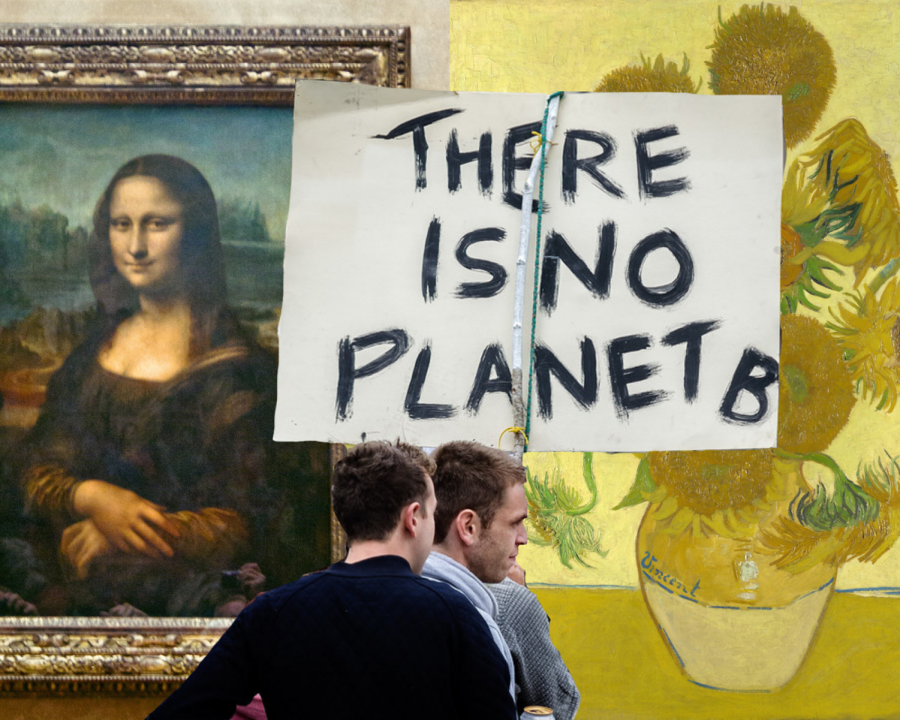Museum stunts are performative activism, not performance art
In attempt to gain attention for calamity of climate change, some protesters attacking famous art pieces.
November 3, 2022
How does throwing Heinz tomato soup at Vincent Van Gogh’s 1888 painting Sunflowers combat climate change?
In the past couple of months, we have seen some of the most recognizable pieces of art in the most renowned museums across the world attacked by a multitude of everyday-household items: German protesters launched mashed potatoes at a Monet, a climate activist glued his head to Vermeer’s Girl With a Pearl Earring, and a man infamously dressed as an old woman ambushed Mona Lisa and her mystifying smile with cake.
These protesters are damaging beloved historical artifacts in order to spotlight climate change’s rapid impact in our environment. “Just Stop Oil” activists Phoebe Plummer and Anna Holland shocked museum-goers at London’s National gallery when they poured soup cans on one of Van Gogh’s most notable pieces of work, Sunflowers.
After gluing herself to the wall, Plummer began a speech: “The cost of living crisis is part of the cost of [the] oil crisis, fuel is unaffordable to millions of cold, hungry families,” she said.
Holland chimed in her statement, “Are you more concerned about the protection of a painting or the protection of our planet and people?” she asked.
Although his still-life was protected by glass and left unharmed, there is a serious issue posed in the trend of vandalizing art to draw attention to completely unrelated matters.
Yes, I do think that there are more pressing concerns on our planet, such as climate change, than art. However, the pieces of hard-working artists who have no connection to our environmental crisis do not deserve to be targeted in the name of climate change awareness.
Awareness plays an extremely important role in the fight for environmental justice. However, what matters even more in saving Earth from an irreversible climate catastrophe is recognizing the legislative change we need to see from politicians and corporations. Smearing food on famous art is not productive, but instead performative; it distracts from the steps we need to take to combat the destruction of our planet.
Some will counter that these protests are “powerful” and “righteous”. After all, if these demonstrations are grabbing media attention, doesn’t that make them effective?
True, more people are aware of the organizations working towards climate action as these radical actions get more attention online. Yet, does that mean they are actually staying informed on laws that contribute to climate change? Is seeing food splattered against archival paintings inspiring to advocate against the corrupt companies and law-makers who actively choose corporations over our planet?
I believe that art can maintain its own protest as cultural currency in our society.
Throughout history, we have seen paintings, sculptures, and many forms of creation act as a tool of resistance against injustice; from declared pacifist Pablo Picasso’s paintings symbolizing tragedies of the Spanish Civil War, such as Guernica, to artists of the AIDS epidemic piercing surrounding political narratives that heavily impacted and targeted the LGBTQ+ community.
More recently, at New York City’s Guggenheim Museum, a collective of anonymous artists showcased 12 posters that read “Women, Life, Freedom,” alongside Mahsa Amini’s picture. The Iranian activists dropped the red banners down the gallery’s famous spiral balcony as a “call for action to support the current revolution in Iran.” Amini was killed at the hands of Iranian Morality Police on Sept. 16, as a result of the country’s religious laws that force women to wear the hijab.
No harm was done to any artwork at the Guggenheim. Yet, the collective still made their voices heard in an influential and effective manner. They expressed their message clearly, which is especially critical in wake of censorship about women’s rights in Iran.
To stay engaged in the fight against climate change, or any social issue that plagues our world, we must stay informed and recognize the harm in throwing food on art. Rather than protests that seem arbitrary or aimless, we can use art as a tool to provoke monumental and significant change.








